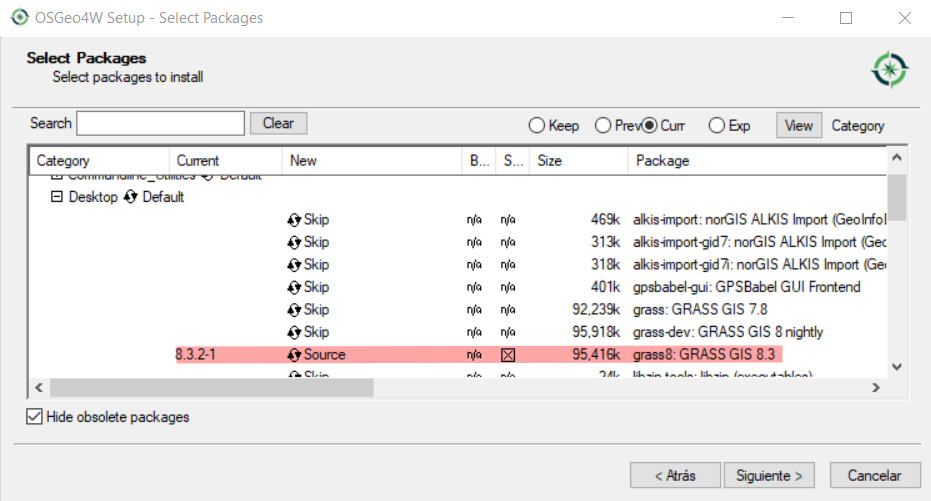# Import standard python packages
import sys
import subprocess
# Ask GRASS GIS where its Python packages are and add them to the path
grass_call = "grass83"
sys.path.append(
subprocess.check_output([grass_call, "--config", "python_path"], text=True, shell=True).strip()
)
# Import the GRASS GIS python packages we need
import grass.script as gs
import grass.jupyter as gj
# Launch a GRASS GIS session.
gj.init("path/to/nc_spm_08_grass/user1");Get started with GRASS in Jupyter Notebooks on Windows
The development of the Python package grass.jupyter, has streamlined the use of GRASS GIS is Jupyter notebooks. In this tutorial we will demonstrate the recommended way of running GRASS GIS in Jupyter Notebooks for Windows users.
Set Up
On Windows, we’ll use the OSGeo4W package manager to setup and update GRASS GIS, Jupyterlab and other dependencies. Follow the directions below to setup Jupyter and GRASS in Windows.
1. Download the OSGeo4W Network Installer
Download the OSGeo4W network install from here. Open it and select “Advanced Install”.
2. Install GRASS GIS, Jupyterlab and grass.jupyter dependencies
Follow the prompts until you get to the “Select Packages” window (the defaults are fine for most situations). Use the Search bar to find and select the following packages for install (switching from “Skip” to the version number):
grasspython3-jupyterlabpython3-ipywidgets

3. Go make a cup of tea
It may take a minute to install… Click “Finish” and exit when it finishes.
4. Open the OSGeo4W Shell and install folium
Launch the OSGeo4W Shell and install folium with:
pip install folium
5. Launch Jupyter Lab
We’re ready to launch jupyterlab now:
jupyter lab
This should launch Jupyter lab in your default web browser. Use the left side panel to navigate to the notebook you wish to run and you’re ready to go!
6. Launching Jupyter Lab in the Future
To launch Jupyter Lab in the future:
- Open the OSGeo4W Shell
- Launch jupyter lab with
jupyter lab
Start GRASS within Jupyter
Now, we’re ready to code! Let’s import the GRASS GIS Python packages and launch GRASS GIS. If you want to run this tutorial, please download and unzip the North Carolina sample dataset.
Using GRASS
Now that we have GRASS GIS running in our notebook, let’s try some basic commands.
In this section, we will set the color table to the elevation raster map from the GRASS GIS sample project we downloaded and then display it.
# Set the computational region to the study area
gs.parse_command("g.region",
raster="elevation",
flags='pg')
# Set colors for elevation raster
gs.run_command("r.colors",
map="elevation",
color="elevation")# Create Map instance
img = gj.Map()
# Add a raster
img.d_rast(map="elevation")
# Add legend
img.d_legend(raster="elevation", at=(55, 95, 80, 84), flags="b")
# Display map
img.show()Now, we’re up and running! Have a look at other tutorials for inspiration on the avenues you can follow with GRASS tools combined with other Python packages.
Troubleshooting
Something not working? Here are some common stumbling blocks…
FileNotFoundError
FileNotFoundError: [WinError 2] The system cannot find the file specifiedCheck the shell parameter in the subprocess.check_output(). On Windows, this should be shell=True. On Mac and Linux operating systems, this should be shell=False.
CalledProcessError
CalledProcessError: Command '['grass83', '--config', 'python_path']' returned non-zero exit status 1.Check which version of GRASS GIS you have installed. On Windows, the grass_call should be grass followed by the first two digits of the version you have installed (for example, GRASS GIS 8.4 would be called with grass84). On Mac and Linux, it should be just grass.
- Errors from
gj.init()
This command takes several different configurations of the GRASS GIS project and mapset location on your system. All the following are examples that work:
gj.init("path/to/grassdata", "project_name", "mapset_name")
gj.init("path/to/project_name/mapset_name")
gj.init("../project_name/mapset_name")Also pay attention to the slash direction. Windows uses \ in it’s file paths but the \ character in strings is also for escaping characters (for example, putting \n in a string will print a new line). Therefore, you’ll need to either switch to forward slashes (/) or put double back-slashes (\\).